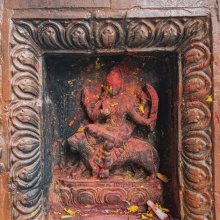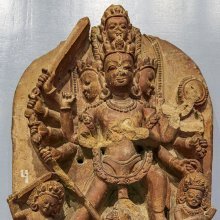Katyayani, Kātyāyanī, Kātyāyaṇī: 12 definitions
Introduction:
Katyayani means something in Hinduism, Sanskrit. If you want to know the exact meaning, history, etymology or English translation of this term then check out the descriptions on this page. Add your comment or reference to a book if you want to contribute to this summary article.
Images (photo gallery)
In Hinduism
Shaktism (Shakta philosophy)
Source: Wisdom Library: ŚāktismKātyāyanī (कात्यायनी):—The name Goddess Durgā took when she emerged from the beams of light radiating from the bodies of the gods to fight the demon named Mahiṣāsura. Durgā represents the combined energies of all the gods.
Source: Google Books: ManthanabhairavatantramKātyāyaṇī (कात्यायणी) refers to a form of the Goddess, according to the Kularatnoddyota (chapter 9).—We are told in the Kularatnoddyota that prior to the goddess’s incarnation in the nineteenth kalpa as Dakṣa’s daughter, she will come into the world to kill the demons Caṇḍa and Muṇḍa. Then as Durgā and Kātyāyaṇī in “a black and brown (kṛṣṇapiṅgalā)” form she will slay Mahiṣa, the king of the demons. She then appears again in the end of the Dvāpara Age, as described in the Purāṇas, to slay the evil king Kaṃsa and thereby save the newly-born Kṛṣṇa. Again, the Jayadrathayāmala says practically the same, identifying the goddess of the nineteenth and last age as Bhadrakālī.
Source: Hare-Krsna: Nava-DurgāKātyāyanī (कात्यायनी) refers to one of the nine Navadurgā which literally means the “nine forms of Goddess Durgā”, and constitute, according to Vedic scriptures, the manifestation of Durgā in Her nine different aspects. [...] Each goddess [viz., Kātyāyanī] has a different form and a special significance.

Shakta (शाक्त, śākta) or Shaktism (śāktism) represents a tradition of Hinduism where the Goddess (Devi) is revered and worshipped. Shakta literature includes a range of scriptures, including various Agamas and Tantras, although its roots may be traced back to the Vedas.
Vaishnavism (Vaishava dharma)
Source: ISKCON Press: GlossaryKātyāyanī (कात्यायनी).—The material energy personified. She is also known as Durgā and Kālī and by many other names.

Vaishnava (वैष्णव, vaiṣṇava) or vaishnavism (vaiṣṇavism) represents a tradition of Hinduism worshipping Vishnu as the supreme Lord. Similar to the Shaktism and Shaivism traditions, Vaishnavism also developed as an individual movement, famous for its exposition of the dashavatara (‘ten avatars of Vishnu’).
Purana and Itihasa (epic history)
Source: archive.org: Puranic EncyclopediaKātyāyanī (कात्यायनी).—One of the two wives of Yājñavalkya. After withdrawing completely from worldly activities, Yājñavalkya asked his wives to divide his worldly assets equally between them. But Maitreyī the other wife, being of a deeply spiritual nature, Kātyāyanī herself had to undertake the burden of all the material affairs. (Bṛhadāraṇyakopaniṣad).
Source: archive.org: Shiva Purana - English TranslationKātyāyanī (कात्यायनी) refers to one of the “nine Durgās” (Navadurgā), participating in Vīrabhadra campaign against Dakṣa, according to the Śivapurāṇa 2.2.33. Accordingly, as Brahmā narrated to Nārada:—“Mahākālī went ahead for the destruction of Dakṣa accompanied by nine Durgās [viz., Kātyāyanī]. Eager in executing the command of Śiva, they accompanied the marching heroes—Ḍākinī, Śākinī, Bhūtas, Pramathas, Guhyakas, Kūṣmāṇḍas, Parpaṭas, Caṭakas, Brahma-Rākṣasas, Bhairavas and Kṣetrapālas and set out quickly for the destruction of Dakṣa’s sacrifice”.
Source: Cologne Digital Sanskrit Dictionaries: The Purana IndexKātyāyanī (कात्यायनी).—Image of; ten hands, three eyes, youthful, killing Mahiṣāsura, and riding the lion.*
- * Matsya-purāṇa 260. 55-66.

The Purana (पुराण, purāṇas) refers to Sanskrit literature preserving ancient India’s vast cultural history, including historical legends, religious ceremonies, various arts and sciences. The eighteen mahapuranas total over 400,000 shlokas (metrical couplets) and date to at least several centuries BCE.
Kavya (poetry)
Source: Wisdom Library: Kathāsaritsāgara1) Kātyāyanī (कात्यायनी) is one of the epithets of Durgā, according to the Kathāsaritsāgara, chapter 53. Accordingly, as Vīravara praised Durgā: “... thou art the principle of life in creatures; by thee this world moves. In the beginning of creation Śiva beheld thee self-produced, blazing and illuminating the world with brightness hard to behold, like ten million orbs of fiery suddenly produced infant suns rising at once, filling the whole horizon with the circle of thy arms, bearing a sword, a club, a bow, arrows and a spear. And thou wast praised by that god Śiva in the following words ... [Kātyāyanī, etc...]”. Also, “... when Skanda, and Vasiṣṭha, and Brahmā, and the others heard thee praised, under these [eg., Kātyāyanī] and other titles, by Śiva well skilled in praising, they also praised thee. And by praising thee, O adorable one, immortals, Ṛṣis and men obtained, and do now obtain, boons above their desire. ”
2) Kātyāyanī (कात्यायनी) is the name of a female religious mendicant (pravrājikā), according to the Kathāsaritsāgara, chapter 101. Accordingly, as Kātyāyanī said to Sundarasena: “... listen, I will tell you the whole story. I am in the habit of wandering about the whole of this earth (pṛthivī) and the islands (dvīpa), for the sake of visiting sacred bathing-places (tīrtha) and other holy spots. And in the course of my travels I happened to visit Haṃsadvīpa”.
The Kathāsaritsāgara (‘ocean of streams of story’), mentioning Kātyāyanī, is a famous Sanskrit epic story revolving around prince Naravāhanadatta and his quest to become the emperor of the vidyādharas (celestial beings). The work is said to have been an adaptation of Guṇāḍhya’s Bṛhatkathā consisting of 100,000 verses, which in turn is part of a larger work containing 700,000 verses.

Kavya (काव्य, kavya) refers to Sanskrit poetry, a popular ancient Indian tradition of literature. There have been many Sanskrit poets over the ages, hailing from ancient India and beyond. This topic includes mahakavya, or ‘epic poetry’ and natya, or ‘dramatic poetry’.
Languages of India and abroad
Sanskrit dictionary
Source: DDSA: The practical Sanskrit-English dictionaryKātyāyanī (कात्यायनी).—
1) An elderly or middle aged widow (dressed in red clothes).
2) Name of a wife of Yajñavalkya मैत्रेयी च कात्यायनी च (maitreyī ca kātyāyanī ca) Bṛ. Up.4.5.1.
3) Name of Pārvatī; cf. उमा कात्यायनी गौरी काली हैमवतीश्वरी (umā kātyāyanī gaurī kālī haimavatīśvarī) Ak.
Source: Cologne Digital Sanskrit Dictionaries: Monier-Williams Sanskrit-English Dictionary1) Kātyāyanī (कात्यायनी):—[from kātyāyana > kātya] a f. Name of one of the two wives of Yājñavalkya, [Śatapatha-brāhmaṇa]
2) [v.s. ...] of a Pravrājikā, [Kathāsaritsāgara]
3) [v.s. ...] of Durgā, [Harivaṃśa; Lalita-vistara; Prabodha-candrodaya]
4) [v.s. ...] a middle-aged widow dressed in red clothes, [cf. Lexicographers, esp. such as amarasiṃha, halāyudha, hemacandra, etc.]
5) [from kātya] b f. of yana q.v.
Source: DDSA: Paia-sadda-mahannavo; a comprehensive Prakrit Hindi dictionary (S)Kātyāyanī (कात्यायनी) in the Sanskrit language is related to the Prakrit words: Kaccāiṇī, Kaccāyaṇī.
Sanskrit, also spelled संस्कृतम् (saṃskṛtam), is an ancient language of India commonly seen as the grandmother of the Indo-European language family (even English!). Closely allied with Prakrit and Pali, Sanskrit is more exhaustive in both grammar and terms and has the most extensive collection of literature in the world, greatly surpassing its sister-languages Greek and Latin.
Kannada-English dictionary
Source: Alar: Kannada-English corpusKātyāyani (ಕಾತ್ಯಾಯನಿ):—
1) [noun] the Goddess Pārvati.
2) [noun] an elderly or middle-aged widow (dressed in red clothes).
3) [noun] a wife of celebrated sage Yājñvalkya.
Kannada is a Dravidian language (as opposed to the Indo-European language family) mainly spoken in the southwestern region of India.
See also (Relevant definitions)
Starts with: Katyayani Shiksha, Katyayanika, Katyayanikalpa, Katyayanike, Katyayanimahatmya, Katyayanipaddhati, Katyayanistava, Katyayanisuta, Katyayanitantra, Katyayanitantroktaprayoga, Katyayanivivaha, Katyayanivrata, Katyayanivratamahatmya, Katyayaniya, Kātyāyanīputra.
Ends with: Dirghakatyayani, Gardabhakatyayani, Karkatyayani, Shanti katyayani, Trikatyayani.
Full-text (+18): Kātyāyanīputra, Katyayani Shiksha, Katyayanikalpa, Kaccaini, Kaccayani, Katyayini, Vishnupanjara, Shanti katyayani, Navadurga, Agamasamgrahe ekajatakalpa, Katyayana, Katyayanisuta, Katyayanitantra, Parvati, Margashirsha, Navagraha, Uttaramnaya, Shashthi, Chaya, Mahisha.
Relevant text
Search found 42 books and stories containing Katyayani, Kātyāyanī, Kātyāyaṇī, Kātyāyani; (plurals include: Katyayanis, Kātyāyanīs, Kātyāyaṇīs, Kātyāyanis). You can also click to the full overview containing English textual excerpts. Below are direct links for the most relevant articles:
Brihad Bhagavatamrita (commentary) (by Śrī Śrīmad Bhaktivedānta Nārāyana Gosvāmī Mahārāja)
Verse 1.7.104-106 < [Chapter 7 - Pūrṇa (pinnacle of excellent devotees)]
Parables of Rama (by Swami Rama Tirtha)
Story 60 - Why things are dear < [Chapter IX - Love]
Garga Samhita (English) (by Danavir Goswami)
Verse 4.3.16 < [Chapter 3 - The Story of the Mithilā Women]
Verse 4.3.3 < [Chapter 3 - The Story of the Mithilā Women]
Historical Elements in the Matsya Purana (by Chaitali Kadia)
Iconography in the Matsya Purāṇa < [Chapter 5 - Cultural history in the Matsya-Purāṇa]
Puranic encyclopaedia (by Vettam Mani)
Related products



